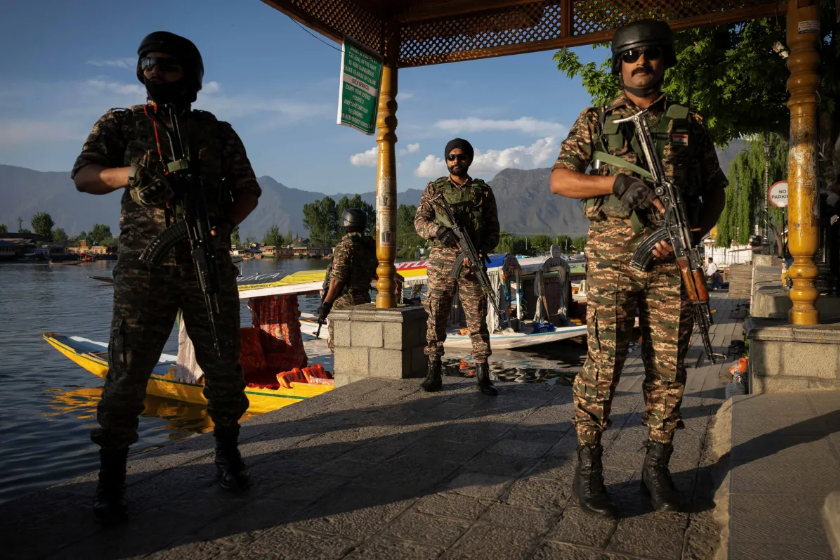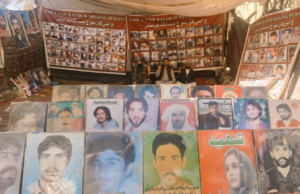
On April 24, Indian Prime Minister Narendra Modi stood before a crowd in the northern state of Bihar and, in a rare shift from his usual Hindi, delivered a warning in English: “India will identify and punish every terrorist and their backers. We will pursue them to the ends of the earth. India’s spirit will never be broken by terrorism. Terrorism will not go unpunished.” The message, spoken just two days after the deadliest attack on civilians in Indian-administered Kashmir in over two decades, was not just for domestic consumption or for Pakistan, which New Delhi blames for the attack; it was a signal to the world that India was preparing a forceful military response.
Kashmir is now once again one of the world’s riskiest flash points. It is not yet clear which group was responsible for the April 22 attack, which killed 26 tourists in Pahalgam, a scenic hill station in Kashmir, but the atrocity has brought India to a sadly familiar juncture. Previous episodes of terrorist violence in Kashmir have led India to strike its neighbor Pakistan, which Indian officials insist is the source of the militancy that still plagues the disputed territory. Modi’s rhetoric this month echoes the speeches he made in 2019 before Indian jets struck Pakistan after a suicide car bomb in Kashmir killed 40 Indian paramilitary soldiers. That year, Pakistan hit back, downing an Indian fighter jet and capturing its pilot, and the two nuclear-armed countries neared the precipice of a widening conflict.
But the situation cooled in 2019, thanks in large part to good fortune. Indian fighter jets missed targets and did not kill anyone inside Pakistan; the Indian pilot survived and was returned promptly by Pakistani forces; and both governments used their control over domestic media to claim victory. Strong intervention by foreign powers, including the United States, incentivized de-escalation. Lisa Curtis, then an official in the Trump administration, noted in 2022 that senior U.S. officials got on the phone with both sides and “worked through a plan to de-escalate and bring down tensions.”
Today, however, the conditions are not as conducive to de-escalation. The situation in Kashmir is more volatile than before. India’s hard-line policies under Modi and the imposition of direct central rule on Kashmir have fueled deep alienation in the Muslim-majority region. The recent massacre has reignited hostilities between India and Pakistan as Indian leaders and public figures call for revenge and Pakistani officials decry India’s policies in Kashmir.
New Delhi could choose simply to attempt a quieter, covert form of retribution against Islamabad, but that is unlikely to satisfy a public that seems to want more concerted action. Overt military action remains a distinct possibility. In 2019, Qamar Javed Bajwa, then Pakistan’s army chief and de facto the most powerful decision-maker in the country, was looking to reconcile with India. By contrast, his successor, Asim Munir, is politically besieged and needs to demonstrate strength; he was already making belligerent statements about India’s actions in Kashmir a week before the April 22 terrorist attack. The Trump administration is not paying a great deal of attention to the region (it has yet to appoint ambassadors to either country, and relevant State Department officials have yet to be confirmed), and unlike in 2019, it has no U.S. forces in nearby Afghanistan to worry about. It is unclear whether the United States will do much to help lower tensions today. With Modi’s rhetoric leaving little room for compromise, Pakistan’s military leadership under pressure to respond forcefully to any Indian strike, and China’s growing involvement in the region, events in Kashmir risk triggering uncontrollable escalation.
A COMBUSTIBLE MIX
At the heart of the Kashmir crisis is a combustible mix of religious nationalism, authoritarian governance, and unresolved political grievances. Modi’s government claims to have returned “normalcy” to Kashmir when, in 2019, it stripped away the constitutional provisions that allowed the disputed territory a form of autonomy. The prime minister and his allies insisted that the move would better integrate the Indian-administered portion of Kashmir, then known as the state of Jammu and Kashmir, into the rest of the country and ensure stability and more rapid economic growth. But ideology drove the government’s Kashmir policy: Modi’s Hindu nationalist Bharatiya Janata Party had long wanted to eliminate the special status enjoyed by India’s only Muslim-majority state, more forcefully subject Kashmir to New Delhi’s control, and erode the distinctness of Kashmiri identity.
Tourism in Kashmir has indeed increased in recent years, with many Indians drawn to its picturesque landscape. But the reality on the ground remains one of pervasive fear and violence. Kashmir has endured recurring militant attacks, including the killing in Pahalgam, and the continued imposition of draconian laws and heavy security deployments. The region’s Muslim-majority population, already alienated by three decades of conflict between Pakistani-backed separatists and Indian security forces, has found itself further disenfranchised and disempowered by the 2019 transformation of Kashmir from a state with a special constitutional status into a union territory directly governed by India’s federal government. The move also opened the region to property purchases by nonresidents, raising concerns about demographic changes and the loss of local control. Authorities have imposed near-total control over information, weakened local governance, and created an environment in which dissent is stifled, leaving the region more unstable and less governable.
These policies have fueled a sense of siege, as have years of security clampdowns, curfews, communication blackouts, and the detention of Kashmiri political leaders. Local elections were suspended for five years. Unsurprisingly, local support for the Indian government has all but dried up, making it harder for security and intelligence services to collect the kind of information that could have headed off this month’s attack.
Modi’s approach to Kashmir is inseparable from his broader political strategy, in which he projects strength as a Hindu nationalist strongman, promises violent retribution against enemies, and seeks to rally domestic support through exploiting moments of national security crisis. Indian officials have framed both the 2019 airstrikes and the “surgical strikes” of 2016—when, according to New Delhi, Indian troops raided militant “launch pads” in Pakistani-held territory after attacks on Indian security forces—as decisive blows against cross-border terrorism. In truth, they had far more political utility than strategic consequence.
Open-source analysis and international reporting cast doubt on the effectiveness of the 2019 strike, yielding little evidence of significant militant casualties or damage to infrastructure. Although the subsequent Pakistani retaliation led to the loss of an Indian fighter jet and the capture of its pilot, the crisis de-escalated because of lucky breaks, with interventions by foreign powers including the United States helping lower temperatures. Indian strikes did not kill anybody in Pakistan, and the Indian pilot shot down over Pakistani territory lived to share a cup of tea with Pakistani soldiers before being delivered back to India unscathed. Both sides were able to claim victory through their pliant national media. In the run-up to the 2019 Indian parliamentary elections, these operations served to burnish Modi’s image as a strong leader who had successfully punished Pakistan.
LOOKING TOUGH, ACTING TOUGH
The recent Pahalgam attack has exposed the hollowness of this strategy. Despite the government’s repeated claims that Indian actions in recent years had established deterrence, militant violence has continued, and the security situation in Kashmir remains fraught. The 2019 strikes did not cow Pakistan or separatist militants; the cycle of attack and reprisal persists, with each incident raising the stakes for escalation between the two nuclear-armed neighbors.
In a memoir published in 2023, former U.S. Secretary of State Mike Pompeo revealed that India and Pakistan came perilously close to a nuclear exchange in February 2019 after India’s airstrikes inside Pakistan, with both sides reportedly preparing for escalation until urgent U.S. intervention helped defuse the crisis. During his election rallies that spring, Modi repeatedly invoked nuclear themes, boasting that India had “called Pakistan’s nuclear bluff” and suggesting that India’s own nuclear arsenal was not just “kept for Diwali,” the Hindu festival in which people set off fireworks. He used such nuclear saber rattling to demonstrate his government’s toughness.
But now, Modi’s rhetoric has boxed him in. Having set a precedent, he faces intense public and political pressure to respond forcefully to each new attack, even when India’s options are limited or risky. The government’s incessant focus on punishing Pakistan—stirred by hypernationalist Indian media coverage—rather than on crafting a coherent long-term strategy with specific requests of its neighbor has narrowed the space for de-escalation and left New Delhi with few tools except coercion by military means.
India will likely initiate cross-border artillery or missile strikes, airstrikes on suspected militant targets, or even limited ground incursions across the line of control (the unofficial border between the Indian- and Pakistani-administered parts of Kashmir), actions intended to be forceful yet fall below the threshold of full-scale war. But they could lead to escalation, prompting immediate Pakistani reprisals, such as retaliatory shelling, airstrikes, or even larger conventional operations, with the ever-present risk of miscalculation triggering broader conflict and, worse, posturing with nuclear weapons.






